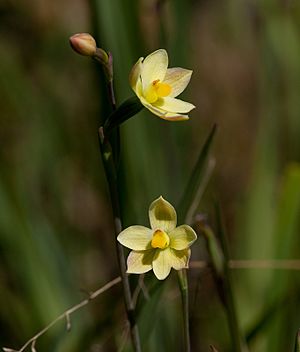Twisted sun orchid facts for kids
Quick facts for kids Twisted sun orchid |
|
|---|---|
 |
|
| Thelymitra flexuosa near Pearcedale | |
| Scientific classification | |
| Genus: |
Thelymitra
|
| Species: |
flexuosa
|
| Synonyms | |
The Thelymitra flexuosa, also known as the twisted sun orchid, is a special type of orchid. It grows only in southern Australia. This orchid has one thin, wire-like leaf. It can have up to four flowers that are cream-coloured or bright yellow. On the back of the flower's central part, called the column, there are four rows of short hairs. This orchid is quite common and can be found in many places. It looks a bit like another orchid called T. antennifera.
Contents
What the Twisted Sun Orchid Looks Like
The twisted sun orchid grows from a tuber (a swollen underground stem, like a potato). It is a perennial plant, meaning it lives for more than two years. It has a single, thin leaf that is about 60 to 150 mm (2.4 to 5.9 inches) long and 3 to 4 mm (0.12 to 0.16 inches) wide.
The plant can grow up to four flowers. These flowers are cream-coloured to bright yellow and are about 10 to 15 mm (0.39 to 0.59 inches) wide. They grow on a stem that is 200 to 350 mm (7.9 to 13.8 inches) tall. The outer parts of the flower, called sepals and petals, are about 5.5 to 7 mm (0.22 to 0.28 inches) long and 4 mm (0.16 inches) wide.
The lowest petal, called the labellum, is a bit shorter and narrower than the others. The central part of the flower, the column, is white to cream-coloured. It is about 4.5 to 5 mm (0.18 to 0.20 inches) long and 2.5 mm (0.098 inches) wide. This column has four lines of short hairs on its back.
The top part of the anther (where pollen is made) is short. It has a few brown glands (small bumps) on its back. The side parts of the column are bright yellow and covered with short hairs.
These flowers do not stay open for long. They mostly open slowly on warm, humid days. They also self-pollinate, meaning they can fertilize themselves. You can see these orchids flowering from September to November.
How the Twisted Sun Orchid Got Its Name
The twisted sun orchid was first officially described in 1839 by a scientist named Stephan Endlicher. He wrote about it in a book called Novarum Stirpium Decades.
The second part of its scientific name, flexuosa, comes from a Latin word. This word means "full of bends," "twisted," or "winding." This name was chosen because the stem where the flowers grow often has a twisted or zig-zag shape.
Where the Twisted Sun Orchid Lives
The twisted sun orchid is very common and can be found in many places across its range. It likes to grow in moist areas, such as the edges of swamps. You will often find it growing near sedges (grass-like plants) and small shrubs.
This orchid grows in several parts of southern Australia. You can find it in southern Victoria, south-eastern South Australia, Western Australia, and Tasmania. In Western Australia, it grows in a wide area from Kalbarri all the way to Israelite Bay.
See also
In Spanish: Thelymitra flexuosa para niños

